#hanfu fashion history
Video
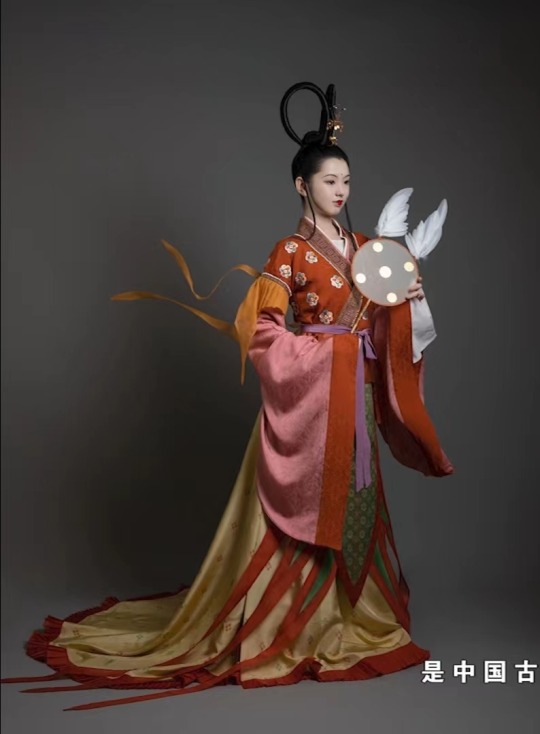

【Reference China Artifacts】
Based On China Eastern Jin Dynasty Silk Painting:《The Goddess of the River Luo /洛神赋图》BY 顾恺之(Song copy ver.)

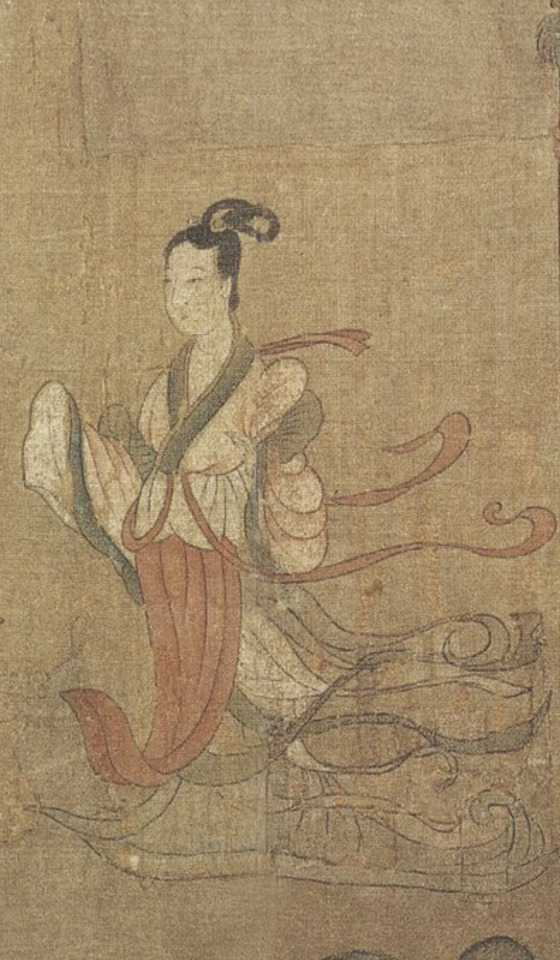

●China Eastern Jin Dynasty Silk Painting:《Exemplary Women of Benevolence and Wisdom /列女仁智图》BY 顾恺之(Song copy ver.)

●Lacquer Screen with Figure Story Paintings from Sima Jinlong Tomb 彩绘人物故事漆屏 (419-484 A.D.)
↓Showing the three great mothers of the Zhou Dynasty royal family - Tai Jiang(太姜), Tai Li(太任/太妊), Tai Si (太姒)



● Eastern Jin Dynasty <Admonitions of the Court Instructress (detail)/ 女史箴圖>by Gu Kaizhi
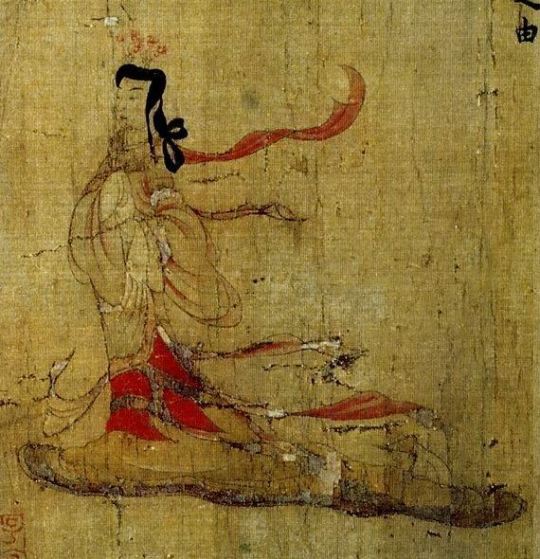
[Hanfu · 漢服]Chinese【Eastern Han Dynasty to Northern and Southern Dynasties】 Traditional Clothing Hanfu & Hairstyle Based On Relics :
【遇鉴文明×装束复原】袿衣发展史(The history of the development of “袿衣/Gui Yi” )
【History Note about “袿衣/Gui Yi” or 杂裾垂髾服 ( "Swallow-tailed Hems and Flying Ribbons clothing" or "swallow tail" ) 】
For more information: https://en.wikipedia.org/wiki/Zaju_chuishao_fu
-----------------------------
This style of clothing is call “袿衣/Gui Yi”, It is the important formal dress of ancient Chinese women.
In the Han Dynasty, people believed that “袿衣/Gui Yi” originated from the dress of the queen's of the Zhou Dynasty.
There are certain differences in the “袿衣/Gui Yi” in each dynasty of china before song.
in Han Dynasty 〈释名・释衣服〉historical document has mentioned:“婦人上服口能,其下垂者,上廣下狹,如刀圭也”
because of the drooping part of this dress is shaped like a knife(刀圭), so is call“袿衣/Gui Yi”.
圭 (A Jade wares held by princes etc during ceremonies):

—————————–
👩Recreation Work :@裝束复原
🔗Weibo:https://weibo.com/1656910125/M30YZpwc4
—————————–
#chinese hanfu#Eastern Han Dynasty#Eastern Jin Dynasty#Northern and Southern Dynasties#袿衣/Gui Yi#hanfu history#hanfu#hanfu accessories#hanfu artifacts#Hanfu Relics#hanfu fashion history#hanfu culture#chinese#chinese traditional clothing#Chinese Culture#Chinese Costume#chinese art#chinese history#historical clothing#historical costuming#historical hairstyles#historical fashion#Hanfu From China#裝束复原#【遇鉴文明×装束复原】袿衣发展史#漢服#汉服#中華風#《The Goddess of the River Luo /洛神赋图》#《Exemplary Women of Benevolence and Wisdom /列女仁智图》
175 notes
·
View notes
Note
Hi my friend wanted to ask about Chinese Opera and the red pom poms on their hats and their significance. I asked my mom and she said they were for decoration so I just wanted clarification
Hi! Thanks for the question, and sorry for taking ages to reply!
The pom poms you see on 盔头/kuitou (Chinese opera headdresses) are called 绒球/rongqiu (lit. "velvet ball"). They are often red, but can also be other colors, and vary in size. Ronqiu are decorative and serve to distinguish the many different types of kuitou from one another. Each type of kuitou is distinct in the number, size, and color of rongqiu that it's decorated with (of course, not all kuitou have rongqiu).
Below - a few different types of Beijing opera kuitou decorated with rongqiu (x):

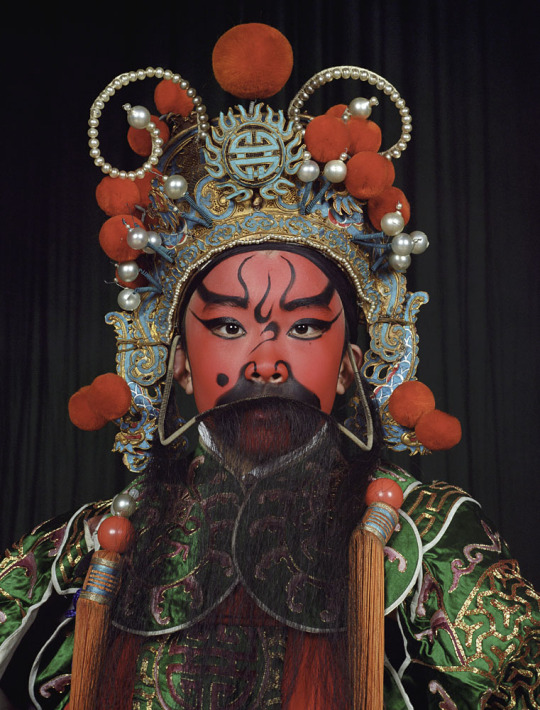
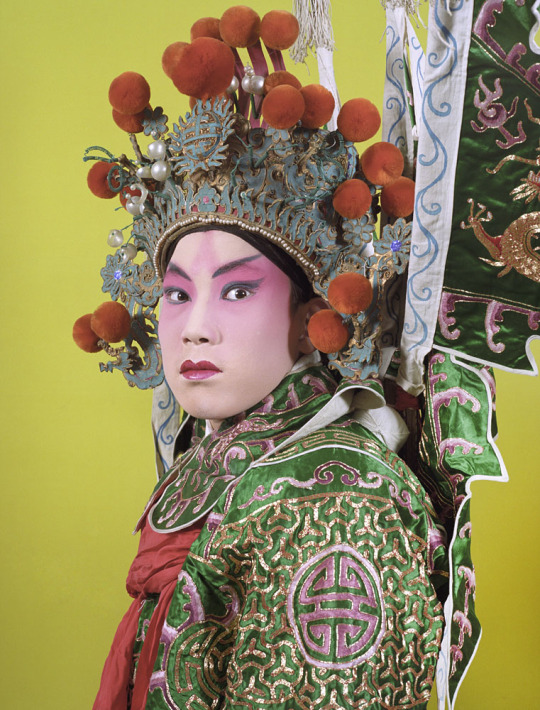
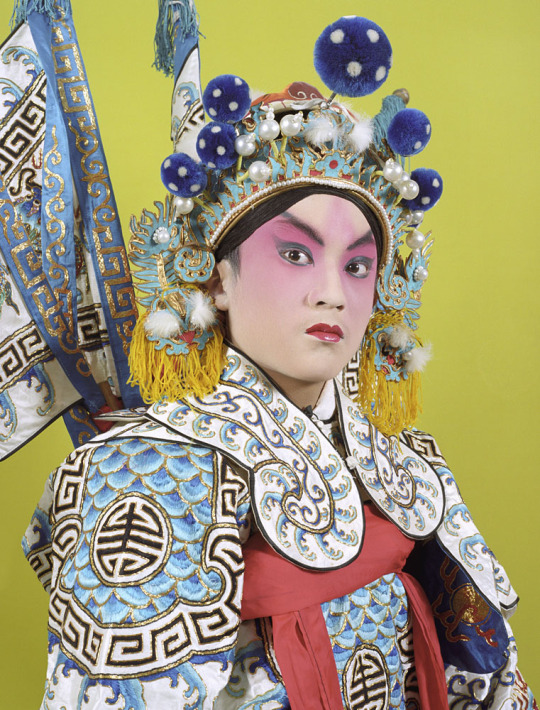

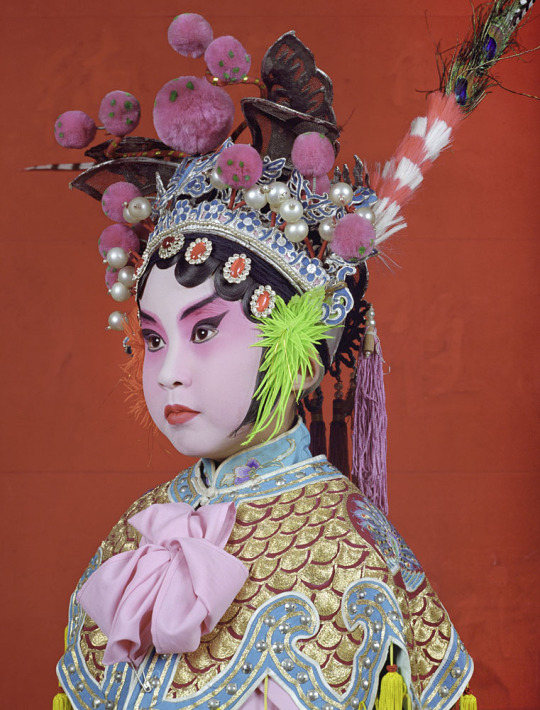
Rongqiu isn't used just for Chinese opera performances - it's a very common decorative item for Chinese headwear, especially for traditional/folk performances.
Below - examples of rongqiu use in folk custom/performance costumes, left to right: 1) 游神/youshen (wandering gods) procession in Fujian (x), 2) 英歌舞/yingge wu (yingge dance) performer in Guangdong (x), 3) & 4) 高跷/gaoqiao (stilt walking) performers in a 社火/shehuo parade in Gansu (x):

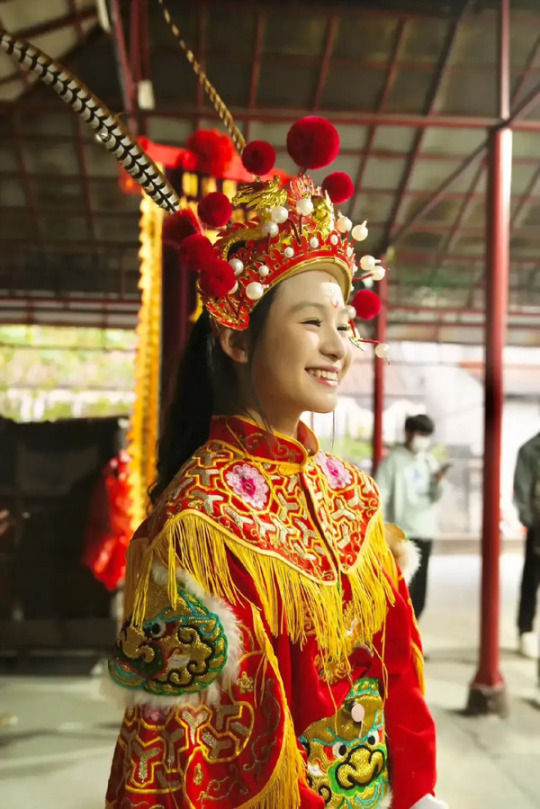

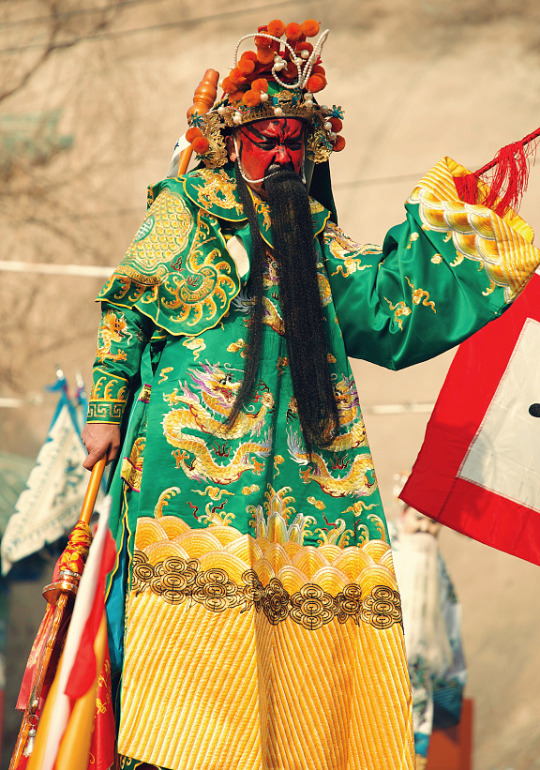
As a festive decoration, rongqiu was also widely used on bridal guan (crowns) from the Qing dynasty into the modern day.
Below - examples of rongqiu use in historical bridal guan: Left - a bride during the late Qing dynasty, circa 1890 (x); Right - a bride during the Republican era/minguo, in 1939 (x):
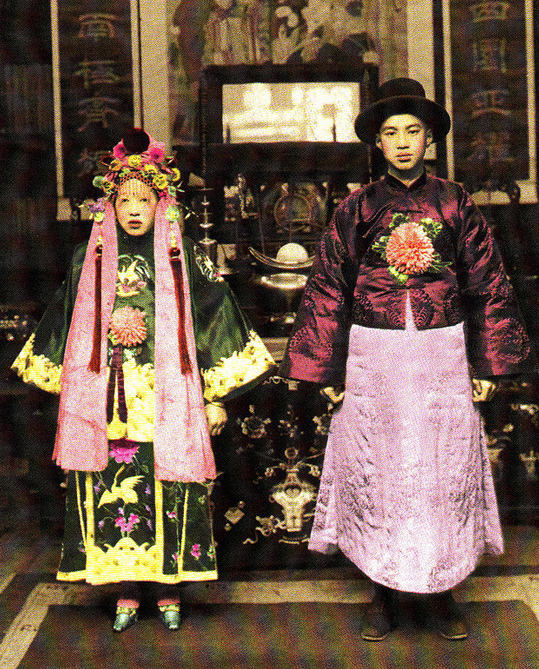
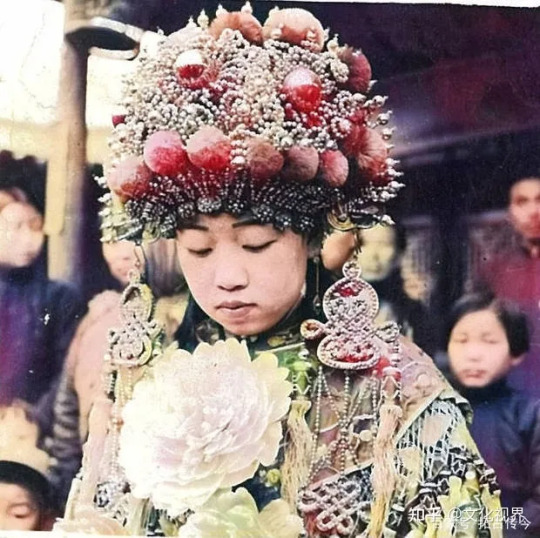
For some reason it's been extremely difficult to find sources on the origin of rongqiu that would shed more light on its significance, but based on historical paintings the use of rongqiu as a head ornament may have originated in the Qing dynasty. During the late Qing dynasty, it was fashionable among women to wear rongqiu on the sides of their hair, as can be seen in the paintings below (x):

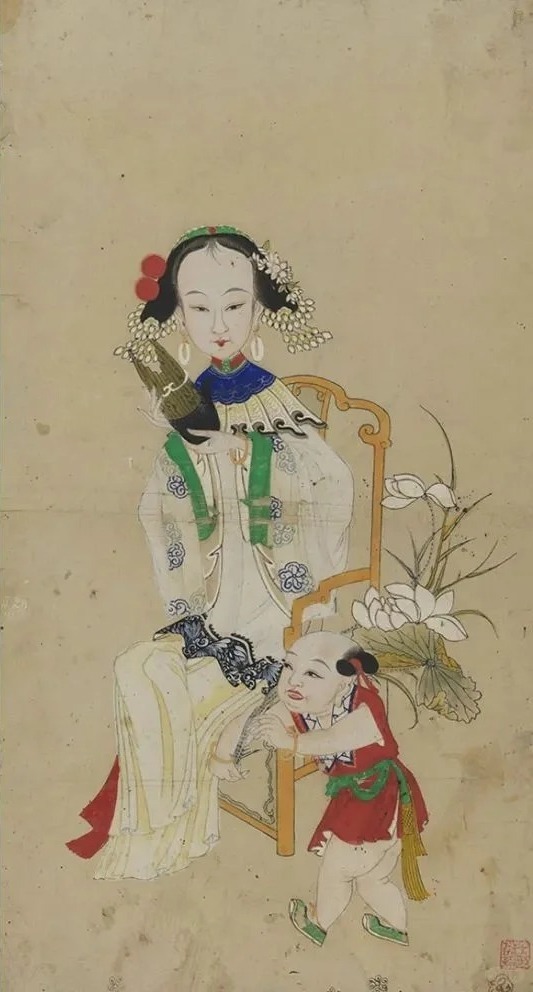
This particular style of rongqiu hair ornament was depicted in the 2012 historical cdrama 娘心计/Mother's Scheme:
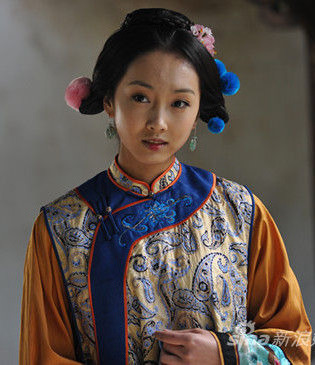
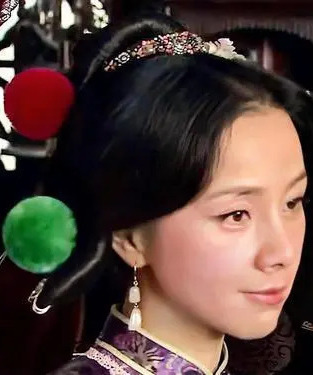
For more references, please see my rongqiu and kuitou tags.
If anyone has more information on the significance of rongqiu, please do share!
Hope this helps ^^
#rongqiu#pompoms#kuitou#chinese opera#opera costume#xifu#hanfu#history#reference#ask#reply#junpeicindystories#chinese fashion#chinese clothing#china
505 notes
·
View notes
Text
perhaps a bit of a long shot but since Ik there are a few hanfu people in the audience, does anyone know where I can find a more regional history of clothing? A lot of sources tend to go by class or time period but I can’t find many sources that focus on like ‘history of hanfu in guangdong’ or ‘clothing history in fujian’. Most of the stuff that pops up are specifically focused on ethnic minority or non-han group clothing history which is nice but not quite what i’m looking for :’(
#im on hiatus bc school has started but#just in case….#diary#hanfu#chinese hanfu#hanfu movement#tagging a lot in case there are people in the tags#chinese history#chinese clothing history#hanfu history#chinese fashion#also if anyone comes onto the og post to look. i can read chinese (and japanese to a point but i doubt theres anything lol) so if u have#any chinese sources…. pspspsps :3
55 notes
·
View notes
Text




等云来【杜若小胖纸】
#hanfu#hanfu art#traditional clothing#traditional chinese clothing#chinese clothing#china#clothing#culture#history#fashion#art
180 notes
·
View notes
Text
Origins of the Pibo: Let’s take a trip along the Silk Road.
1. Introduction to the garment:
Pibo 披帛 refers to a very thin and long shawl worn by women in ancient East Asia approximately between the 5th to 13th centuries CE. Pibo is a modern name and its historical counterpart was pei 帔. But I’ll use pibo as to not confuse it with Ming dynasty’s xiapei 霞帔 and a much shorter shawl worn in ancient times also called pei.
Below is a ceramic representation of the popular pibo.
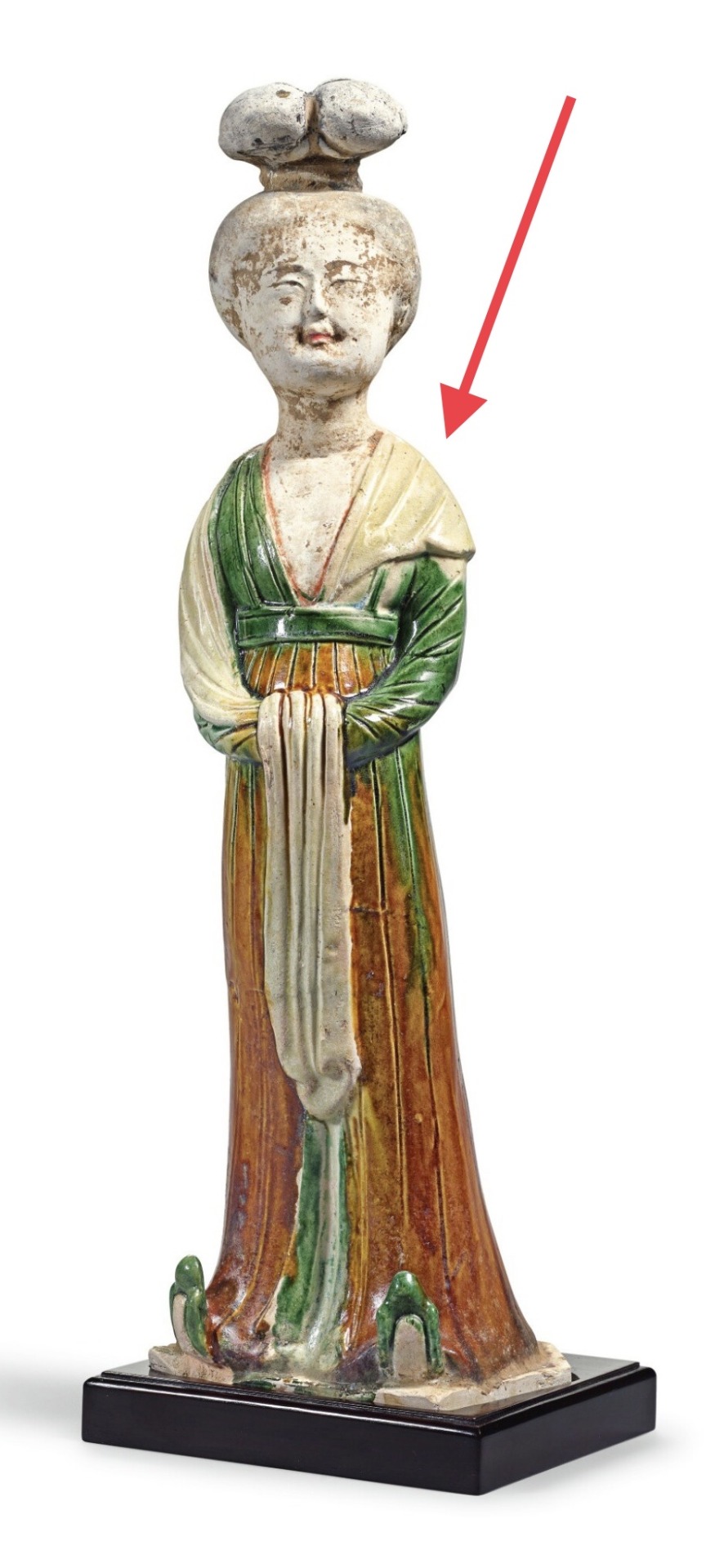
A sancai-glazed figure of a court lady, Tang Dynasty (618–690, 705–907 CE) from the Sze Yuan Tang Collection. Artist unknown. Sotheby’s [image source].
Although some internet sources claim that pibo in China can be traced as far back as the Qin (221-206 BCE) or Han (202 BCE–9 CE; 25–220 CE) dynasties, we don’t start seeing it be depicted as we know it today until the Northern and Southern dynasties period (420-589 CE). This has led to scholars placing pibo’s introduction to East Asia until after Buddhism was introduced in China. Despite the earliest art representations of the long scarf-like shawl coming from the Northern and Southern Dynasties period, the pibo reached its popularity apex in the Tang Dynasty (618–690 CE: 705–907 CE).
Academic consensus: Introduction via the Silk Road.
The definitive academic consensus is that pibo evolved from the dajin 搭巾 (a long and thin scarf) worn by Buddhist icons introduced to China via the Silk Road from West Asia.
披帛是通过丝绸之路传入中国的西亚文化, 与中国服饰发展的内因相结合而流行开来的一种"时世妆" 的形式. 沿丝绸之路所发现的披帛, 反映了丝绸贸易的活跃.
[Trans] Pibo (a long piece of cloth covering the back of the shoulders) was a popular female fashion period accessory introduced to China by West Asian cultures by way of the Silk Road and the development of Chinese costumes. The brocade scarves found along the Silk Road reflect the prosperity of the silk trade that flourished in China's past (Lu & Xu, 2015).
I want to add to the above theory my own speculation that, what the Chinese considered to be dajin, was most likely an ancient Indian garment called uttariya उत्तरीय.
2. Personal conjecture: Uttariya as a tentative origin to pibo.
In India, since Vedic times (1500-500 BCE), we see mentions in records describing women and men wearing a thin scarf-like garment called “uttariya”. It is a precursor of the now famous sari. Although the most famous depiction of uttariya is when it is wrapped around the left arm in a loop, we do have other representations where it is draped over the shoulders and cubital area (reverse of the elbow).
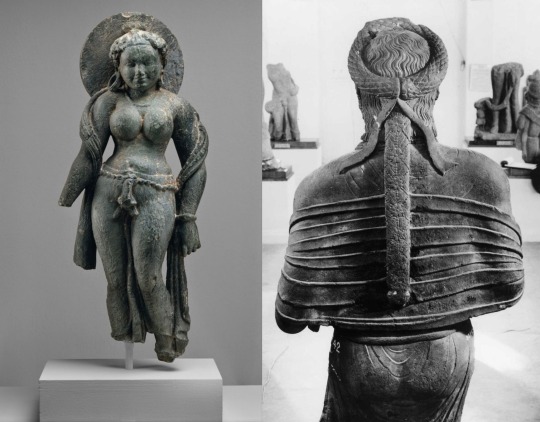
Left: Hindu sculpture “Mother Goddess (Matrika)”, mid 6th century CE, gray schist. Artist unknown. Looted from Rajasthan (Tanesara), India. Photo credit to Metropolitan Museum of Art, New York, United States [image source].
Right: Rear view of female statue possibly representing Kambojika, the Chief Queen of Mahakshatrapa Rajula, ca. 1st century CE. Artist unknown. Found in the Saptarishi Mound, Mathura, India. Government Museum, Mathura [image source].
Buddhism takes many elements from Hindu mythology, including apsaras अप्सरा (water nymphs) and gandharvas गन्धर्व (celestial musicians). The former was translated as feitian 飞天 in China. Hindu deities were depicted wearing clothes similar to what Indian people wore, among which we find uttariya, often portrayed in carvings and sculptures of flying and dancing apsaras or gods to show dynamic movement. Nevertheless, uttariya long predated Buddhism and Hinduism.
Below are carved representation of Indian apsaras and gandharvas. Notice how the uttariya are used.

Upper left: Carved relief of flying celestials (Apsara and Gandharva) in the Chalukyan style, 7th century CE, Chalukyan Dynasty (543-753 CE). Artist Unknown. Aihole, Karnataka, India. National Museum, New Delhi, India [image source]. The Chalukyan art style was very influential in early Chinese Buddhist art.
Upper right: Carved relief of flying celestials (gandharvas) from the 10th to the 12th centuries CE. Artist unknown. Karnataka, India. National Museum, New Delhi, India [image source].
Bottom: A Viyadhara (wisdom-holder; demi-god) couple, ca. 525 CE. Artist unknown. Photo taken by Nomu420 on May 10, 2014. Sondani, Mandsaur, India [image source].
Below are some of the earliest representations of flying apsaras found in the Mogao Caves, Gansu Province, China. An important pilgrimage site along the Silk Road where East and West met.
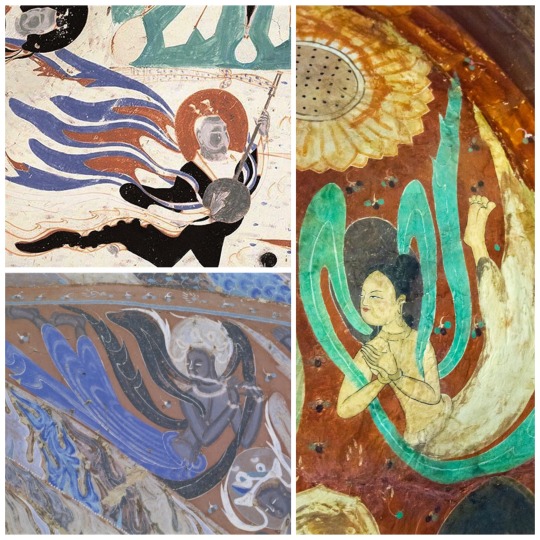
Left to right: Cave No. 461, detail of mural in the roof of the cave depicting either a flying apsara or a celestial musician. Western Wei dynasty (535–556 CE). Artist unknown. Mogao Grottoes, Dunhuang, China [image source].
Cave 285 flying apsara (feitian) in one of the Mogao Caves. Western Wei Dynasty (535–556 CE), Artist unknown. Photo taken by Keren Su for Getty Images. Mogao Grottoes, Dunhuang, China [image source].
Cave 249. Mural painting of feitian playing a flute, Western Wei Dynasty (535-556 CE). Image courtesy by Wang Kefen from The Complete Collection of Dunhuang Grottoes, Vol. 17, Paintings of Dance, The Commercial Press, Hong Kong, 2001, p. 15. Mogao Grottoes, Dunhuang, China [image source].
I theorize that it is likely that the pibo was introduced to China via Buddhism and Buddhist iconography that depicted apsaras (feitian) and other deites wearing uttariya and translated it to dajin.
3. Trickle down fashion: Buddhism’s journey to the East.
However, since Buddhism and its Indian-based fashion spread to West Asia first, to Sassanian Persians and Sogdians, it is likely that, by the time it reached the Han Chinese in the first century CE, it came with Persian and Sogdian influence. Persians’ fashion during the Sassanian Empire (224–651 CE) was influenced by Greeks (hellenization) who also had a a thin long scarf-like garment called an epliblema ἐπίβλημα, often depicted in amphora (vases) of Greek theater scenes and sculptures of deities.

Left to right: Dame Baillehache from Attica, Greece. 3rd century BCE, Hellenistic period (323-30 BCE), terracotta statuette. Photo taken by Hervé Lewandowski. Louvre Museum, Paris, France [image source].
Deatail view of amphora depicting the goddess Artemis by Athenian vase painter, Andokides, ca. 525 BCE, terracotta. Found in Vulci, Italy. Altes Museum, Berlin, Germany [image source].
Statue of a Kore (young girl), ca. 570 BCE, Archaic Period (700-480 BCE), marble. Artist unknown. Uncovered from Attica, Greece. Acropolis Museum, Athens, Greece [image source].
Detail view of Panathenaic (Olympic Games) prize amphora with lid, 363–362 BCE, Attributed to the Painter of the Wedding Procession and signed by Nikodemos, terracotta. Uncovered from Athens, Greece. J. Paul Getty Museum, Los Angeles, California, United States [image source].
Roman statue depicting Euterpe, muse of lyric poetry and music, ca. 2nd century CE, marble, Artist unknown. From the Villa of G. Cassius Longinus near Tivoli, Italy. Photo taken by Egisto Sani on March 12, 2012, Vatican Museums, Rome, Italy [image source].
Greek (or Italic) tomb mural painting from the Tomb of the Diver, ca. 470 BCE, fresco. Artist unknown. Photo taken by Floriano Rescigno. Necropolis of Paestum, Italy [image source].
Below are Iranian and Iraqi period representations of this long thin scarf.

Left to right: Closeup of ewer likely depicting a female dancer from the Sasanian Period (224–651 CE) in ancient Persia , Iran, 6th-7th century CE, silver and gilt. Artist unknown. Mary Harrsch. July 10, 2015. Arthur M. Sackler Gallery of Asian Art, Smithsonian, Washington D.C [image source].
Ewer with nude dancer probably representing a maenad, companion of Dionysus from the Sasanian Period (224–651 CE) in ancient Persia, Iran, 6th-7th century CE, silver and gilt. Artist unknown. Mary Harrsch. July 16, 2015. Arthur M. Sackler Gallery of Asian Art, Smithsonian, Washington D.C [image source].
Painting reconstructing the image of unveiled female dancers depicted in a fresco, Early Abbasid period (750-1258 CE), about 836-839 CE from Jawsaq al-Khaqani, Samarra, Iraq. Museum of Turkish and Islamic Art, Istanbul [image source].
The earliest depictions of Buddha in China, were very similar to West Asian depictions. Ever wonder why Buddha wears a long draped robe similar to a Greek himation (Romans called it toga)?
Take a look below at how much the Greeks influenced the Kushans in their art and fashion. The top left image is one of the earliest depictions of Buddha in China. Note the similarities between it and the Gandhara Buddha on the right.
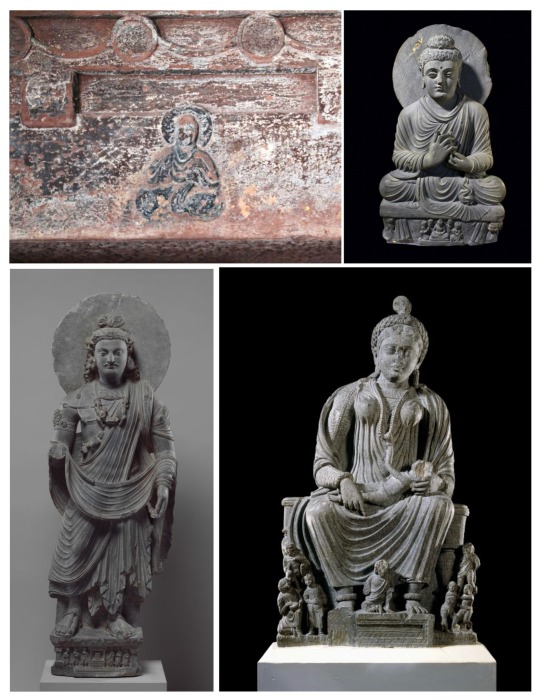
Left: Seated Buddha, Mahao Cliff Tomb, Sichuan Province, Eastern Han Dynasty, late 2nd century C.E. (photo: Gary Todd, CC0).
Right: Seated Buddha from Gandhara, Pakistan c. 2nd–3rd century C.E., Gandhara, schist (© Trustees of the British Museum)
Standing Bodhisattva Maitreya (Buddha of the Future), ca. 3rd century, gray schist. From Gandhara, Pakistan. Image credit to The Metropolitan Museum of Art, New York City, United States [image source].
Statue of seated goddess Hariti with children, ca. 2nd to 3rd centuries CE, schist. Artist unknown. From Gandhara, Pakistan. The British Museum, London, England [image source].
Before Buddhism spread outside of Northern India (birthplace), Indians never portrayed Buddha in human form.
Early Buddhist art is aniconic, meaning the Buddha is not represented in human form. Instead, Buddha is represented using symbols, such as the Bodhi tree (where he attained enlightenment), a wheel (symbolic of Dharma or the Wheel of Law), and a parasol (symbolic of the Buddha’s royal background), just to name a few. […] One of the earliest images [of Buddha in China] is a carving of a seated Buddha wearing a Gandharan-style robe discovered in a tomb dated to the late 2nd century C.E. (Eastern Han) in Sichuan province. Ancient Gandhara (located in present-day Afghanistan, Pakistan, and northwest India) was a major center for the production of Buddhist sculpture under Kushan patronage. The Kushans occupied portions of present-day Afghanistan, Pakistan, and North India from the 1st through the 3rd centuries and were the first to depict the Buddha in human form. Gandharan sculpture combined local Greco-Roman styles with Indian and steppe influences (Chaffin, 2022).
In the Mogao Caves, which contain some of the earliest Buddhist mural paintings in China, we see how initial Chinese Buddhist art depicted Indian fashion as opposed to the later hanfu-inspired garments.

Left to right: Cave 285, detail of wall painting, Western Wei dynasty (535–556 CE). Mogao Grottoes, Dunhuang, China. Courtesy the Dunhuang Academy [image source]. Note the clothes the man is wearing. It looks very similar to a lungi (a long men’s skirt).
Photo of Indian man sitting next to closed store wearing shirt, scarf, lungi and slippers. Paul Prescott. February 20, 2015. Varanasi, India [image source].
Cave 285, mural depiction of worshipping bodhisattvas, 6th century CE, Wei Dynasty (535-556 A.D.), Unknown artist. Mogao Grottoes, Dunhuang, China. Notice the half bow on his hips. That is a common style of tying patka (also known as pataka; cloth sashes) that we see throughout Indian history. Many of early Chinese Buddhist paintings feature it, including the ones at Mogao Caves.
Indian relief of Ashoka wearing dhoti and patka, ca. 1st century BC, Unknown artist. From the Amaravathi village, Guntur district, Andhra Pradesh, India. Currently at the Guimet Museum, Paris [image source].
Cave 263. Mural showing underlying painting, Northern Wei Dynasty (386–535 CE). Artist Unknown. Picture taken November 29, 2011, Mogao Grottoes, Dunhuang, China [image source]. Note the pants that look to be dhoti.
Comparison photo of modern dhoti advertisement from Etsy [image source].
Spread of Buddhism to East Asia.

Map depicting the spread of Buddhism from Northern India to the rest of Asia. Gunawan Kartapranata. January 31, 2014 [image source]. Note how Mahayana Buddhism arrived to China after passing through Kushan, Bactrean, and nomadic steppe lands, absorbing elements of each culture along the way.
Wealthy Buddhist female patrons emulated the fantasy fashion worn by apsaras, specifically, the uttariya/dajin and adopted it as an everyday component of their fashion.

Cave 285. feitian mural painting on the west wall, Western Wei Dynasty (535–556 CE). Artist unknown. Mogao Grottoes, Dunhuang, China [image source].
Cave 285. Detail view of offering bodhisattvas (bodhisattvas making offers to Buddha) next to the phoenix chariot on the Western wall of the cave. Western Wei Dynasty (535–556 CE). Artist unknown. Mogao Grottoes, Dunhuang, China [image source].
Cave 61 Khotanese (from the kingdom of Khotan 于阗 [56–1006 CE]) donor ladies, ca. 10th century CE, Five Dynasties period (907 to 979 CE). Artist unknown. Picture scanned from Zhang Weiwen’s Les oeuvres remarquables de l'art de Dunhuang, 2007, p. 128. Uploaded to Wikimedia Commons on October 11, 2012 by Ismoon. Mogao Grottoes, Dunhuang, China [image source].
Detail view of Ladies Adorning Their Hair with Flowers 簪花仕女图, late 8th to early 9th century CE, handscroll, ink and color on silk, Zhou Fang 周昉 (730-800 AD). Liaoning Provincial Museum, Shenyang, China [image source].
Therefore, the theory I propose of how the pibo entered East Asia is:
India —> Greek influenced West Asia (Sassanian Persians, Sogdians, Kushans, etc…) —> Han China —> Rest of East Asia (Three Kingdoms Korea, Asuka Japan, etc…)
Thus, the most likely theory, in my person opinion, is Buddhist iconography depicting uttariya encountered Greek-influenced West Asian Persian, Sogdian, and Kushan shawls, which combined arrived to China but wouldn’t become commonplace there until the explosion in popularity of Buddhism from the periods of Northern and Southern Dynasties to Song.
References:
盧秀文; 徐會貞. 《披帛與絲路文化交流》 [The brocade scarf and the cultural exchanges along the Silk Road]. 敦煌研究 (中國: 敦煌研究編輯部). 2015-06: 22 – 29. ISSN 1000-4106.
#hanfu#chinese culture#chinese history#buddhism#persian#sogdian#kushan#gandhara#indian fashion#uttariya#pibo#history#asian culture#asian art#asian history#asian fashion#east asia#south asia#india#pakistan#iraq#afghanistan#sassanian#silk road#fashion history#tang dynasty#eastern han dynasty#cultural exchange#greek fashion#mogao caves
283 notes
·
View notes
Video
youtube
Chinese Hats and Headwear in the Three Kingdoms 1994 and its history
One of our contributors @csarracenian has subtitled another educational video about the history of various hats and headwear in the 1994 Romance of the Three Kingdoms, explaining their history and meaning and showcasing the high research quality of the show.
Video is made by 是椰果啊 on bilibili & released with their permission.
#three kingdoms#chinese drama#dynasty warriors#chinese history#hanfu#historical#period drama#romance of the three kingdoms 1994#rotk#汉服#冠#history#clothing history#fashion history#ancient china
133 notes
·
View notes
Text
Hello everyone! As a Chinese person interested in hanfu, I have a question. Does anybody know what crown is the Chinese philosopher Confucius wearing in these portraits? Thank you!


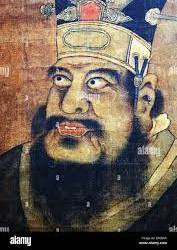

#hanfu#chinese#chinese history#ancient china#china#warring states era#warring states period#chinese fashion#hanfu accessories#hanfu movement#tang dynasty#han dynasty#qin dynasty#ming dynasty#chinese hanfu#chinese culture
172 notes
·
View notes
Note
Thank the Valars ur back!!!💖💖💖 But if you need your rest, take them and have time! Remember we'll all support you always no matter what!😇until you post another i will wait patiently..... I am so thankful to you since I read the silm after i saw all ur amazing works.
Ps. I made this tumblr account to send❤❤❤❤to u and ur works. People like u always make my day! I wish I can draw and make headcannons like u! 😢 I think ill have to stop since the ps shhouldnt be longer than the tezt above(idk what they call that... I am EFL so i think im forgivable😎)
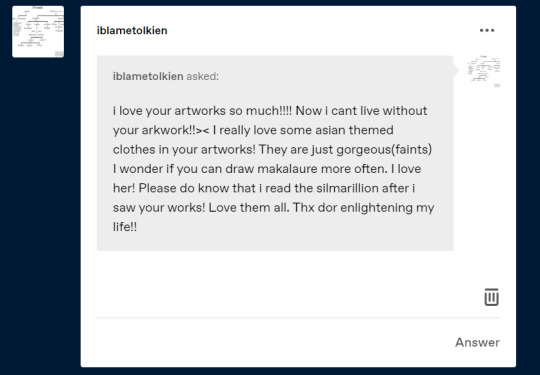
hiiiii!!! thank you for all your encouraging words and for taking the time to send in such kind messages ahhhh 🥺 im really honoured you like the stuff i put out! i have a lot of fun drawing them, and learning other people enjoy it too really gives motivation to all my doodles 🙇♀️ also you read the silm after finding my work?? 😭💖 that's very high praise but u are far too kind! the tolkien community here on tumblr is such a wonderful place with so many talented creators and amazing content, so i hope you continue to explore and enjoy your time!!!
i must send this back to you, because people like you make my day as well ❤❤❤ And don't give up!!! anyone can draw and make headcanons so long as they have an idea of what they wanna do-- that's the fun and freedom of fanwork, isn't it! i hope one day to see you putting your stuff out there as well... ehehee... 🥳
i'm also very happy you like the Asian-themed clothes in my artwork! i really do enjoy studying historical and traditional clothes, and i hope to keep incorporating them into my designs over time. since you asked for makalaure, here is a little doodle of him and maedhros in hanbok :DDD

i wanted to practice studying some more traditional styles, so i did a few other sketches of Maglor in various styles of historical East Asian styles + idril, nerdanel, and aredhel to model some female clothes hehe....

thanks again for your wonderful support bc it's really made my day, and hey!!! im super guilty of rambling too much in all my posts so honestly, write as much as you want in the P.S.s because word limits are a goofy concept 😎 all the best with ur EFL studies friend-- u can do it!!! fighting!!!! 💪 and have a wonderful rest of your day!
#silmarillion#rin replies#iblametolkien#i do as well.... professor ily but why do you hurt us like this 😭#maglor#maedhros#the silmarillion fanart#silm#i rly like incorporating east asian styles into my designs but i wanna start exploring southeast asian styles soon too hehe#i started off with me watching too many wuxia drama and reading a lot of sageuk manhwa but now its genuinely a big big interest of mine#ziseviolet has an amazing archive of hanfu styles over the different dynasties id totally recommend if ur interested!#fashion history is fun qwq#but apologies if i got any names wrong ;;#but yes!! thank you again!!!!#idril#aredhel#maeglin#nerdanel#sketch dump#doodles#sketches#silm art#sakasakart
114 notes
·
View notes
Text
Ugh. Why is it so difficult to find info on men's clothing? 90% of the websites I visit are about women's clothing only. Sometimes with a very small paragraph or two on men's clothing. Ugh. Whyyyyyyy.
#hanfu#chinese history#historical fashion#chinese fashion#sui dynasty#tang dynasty#northern and southern dynasties#wei and jin dynasties#history of hanfu
15 notes
·
View notes
Photo
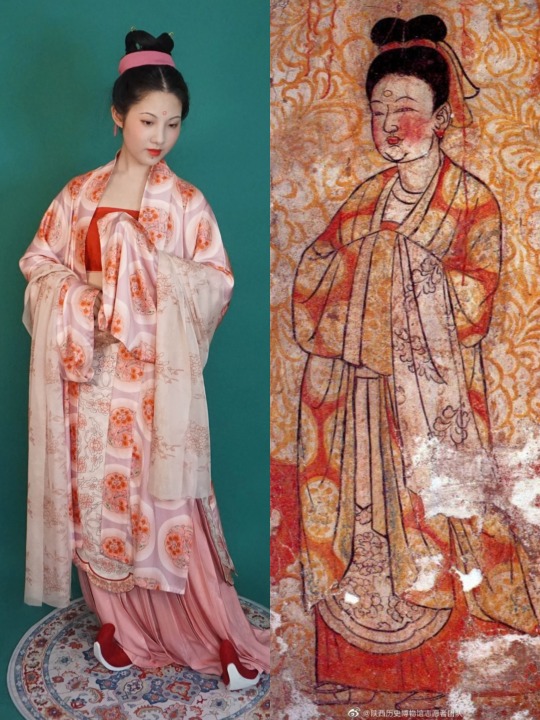
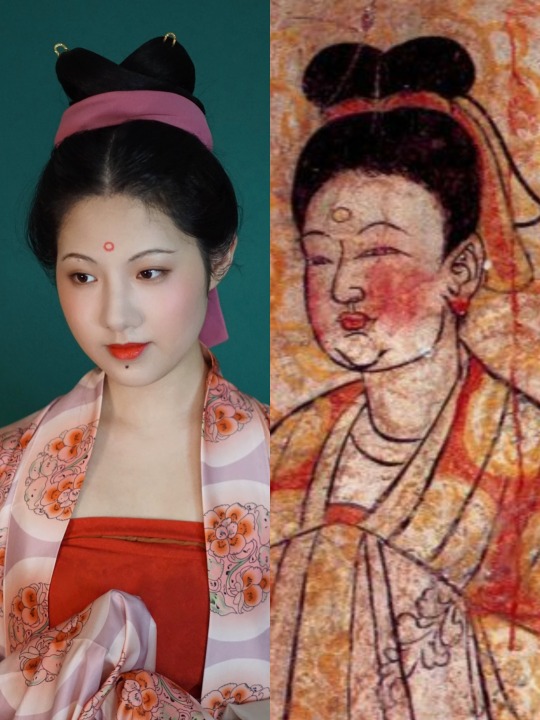
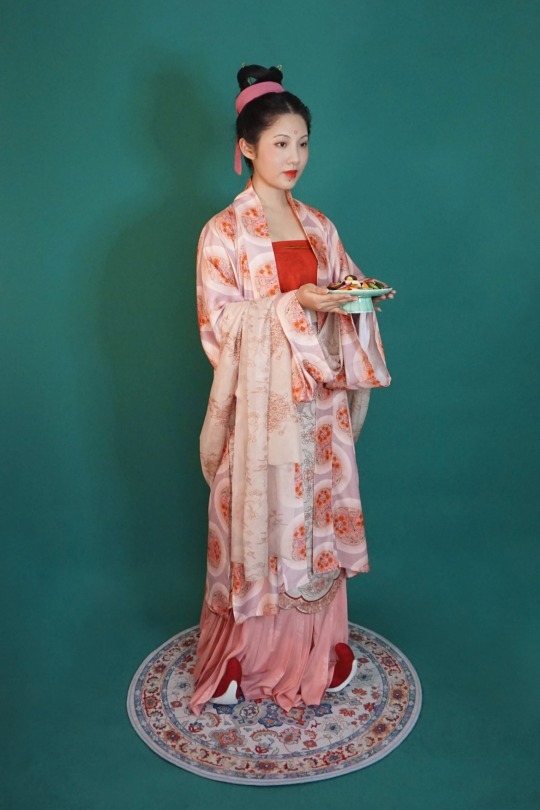
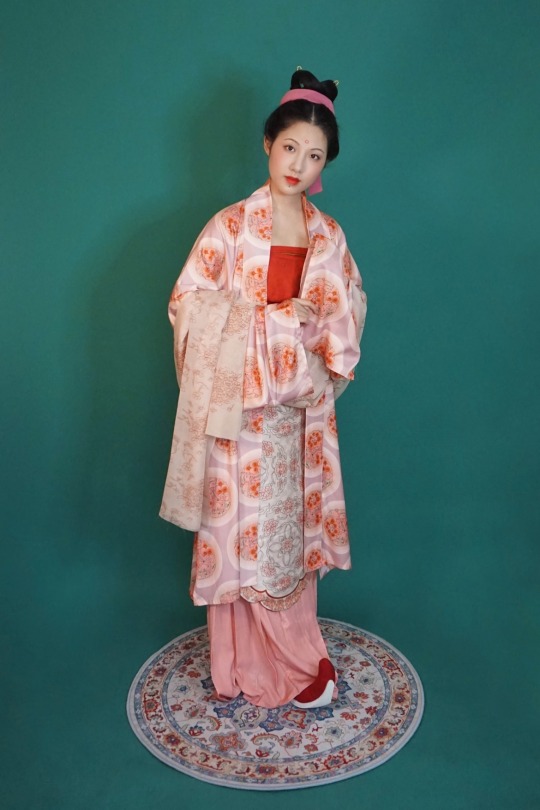
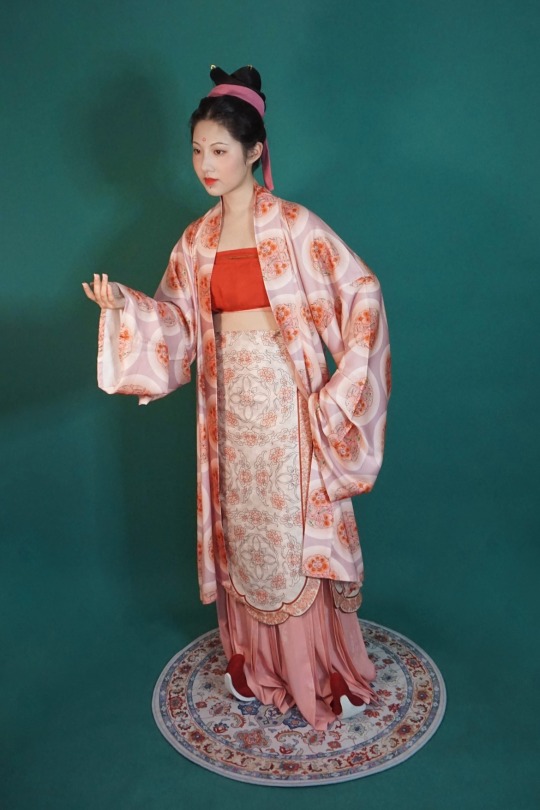
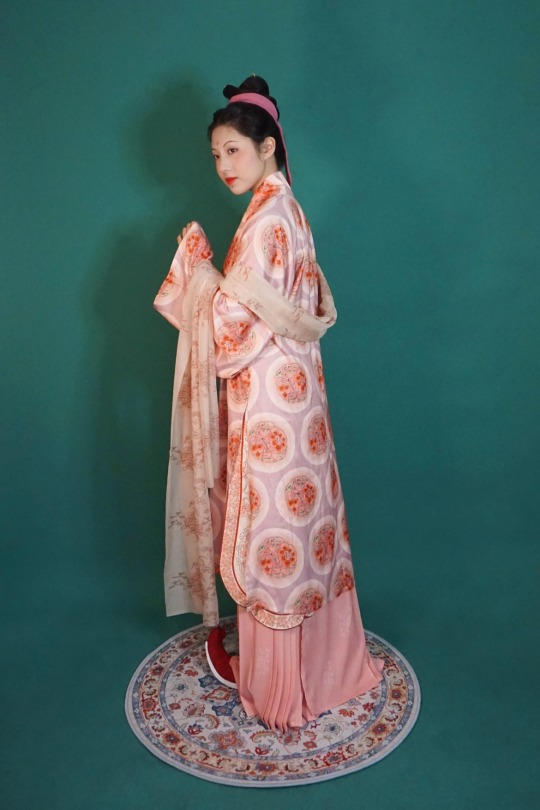

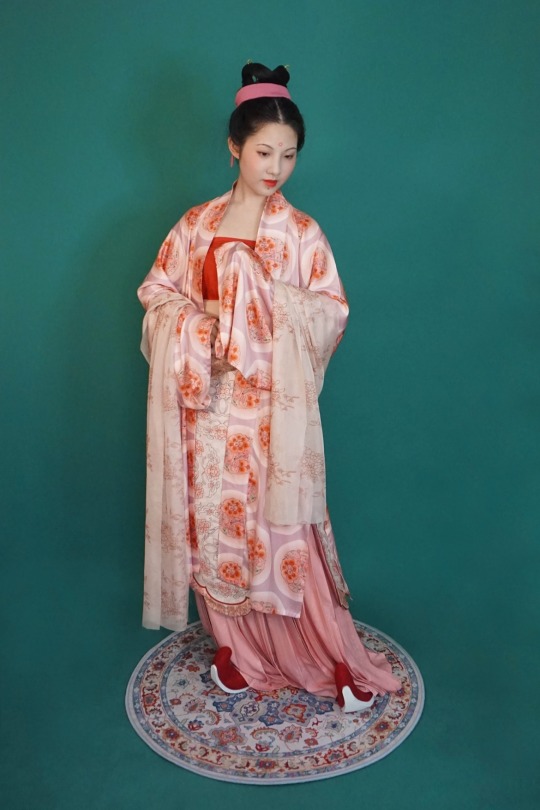

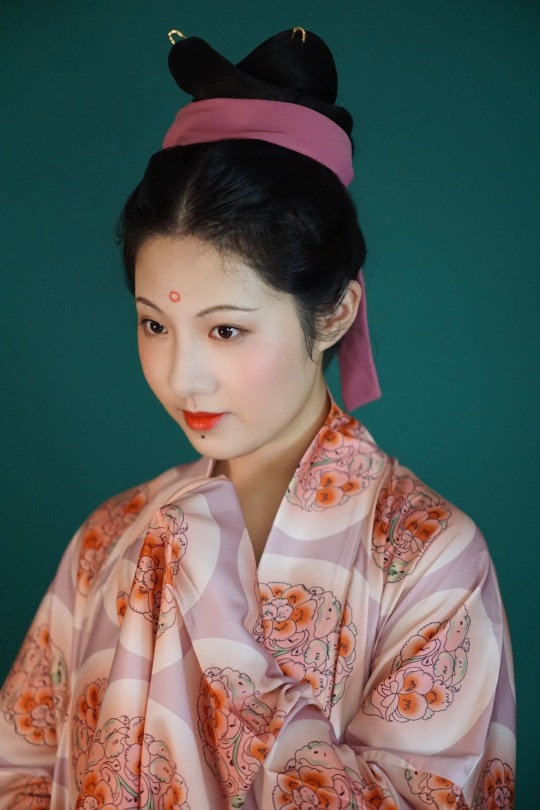
【Reference Artifacts】:
・ Five Dynasties Period (958 CE) Mural : <Beauty>
5th Year of Xiande Era of Later Zhou of the Five Dynasties Period (958 CE).
Height ca. 133cm Unearthed from Feng Hui's Tomb in Binxian, Shaanxi, in 1992. Preserved in Xianyang Center for the Conservation of Cultural
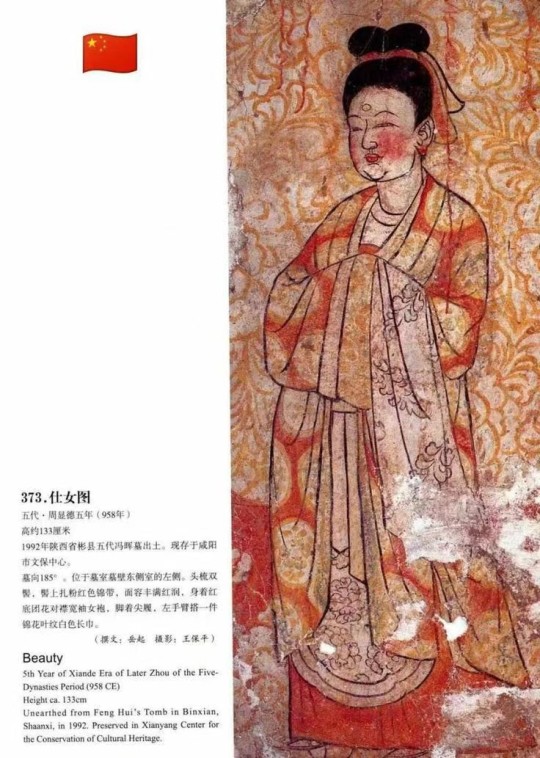
[Hanfu · 漢服]Chinese 【Five Dynasties And Ten Kingdoms Period】 Traditional Clothing Hanfu & Hairstyle Based On Mural <Beauty> Unearthed from Feng Hui's Tomb
_______
Recreation Work:@青泠谷汉服工作室
Hanfu:@青泠谷汉服工作室
Model:@ -盥薇-
🔗 Taobao:https://item.taobao.com/item.htm?spm=a1z0k.7385961.0.d4919233.37c937de6RvCYY&id=684591182349&_u=t2dmg8j26111
_______
#Chinese Hanfu#hanfu#Five Dynasties And Ten Kingdoms Period#Feng Hui's Tomb#Beauty#hanfu history#hanfu accessories#hanfu artifacts#hanfu_challenge#chinese history#chinese#hanfu fashion history#Chinese Costume#Chinese Culture#chinese art#chinese style#chinese fashion history#historical clothing#historical fashion#historical hairstyles#historical costuming#hanfu recreation#Hanfu From China#青泠谷汉服工作室#-盥薇-#漢服#汉服#五代十国#仕女图
107 notes
·
View notes
Text
Abridged History of Qing Dynasty Han Women’s Fashion (part 1: Late Ming & Shunzhi Era)
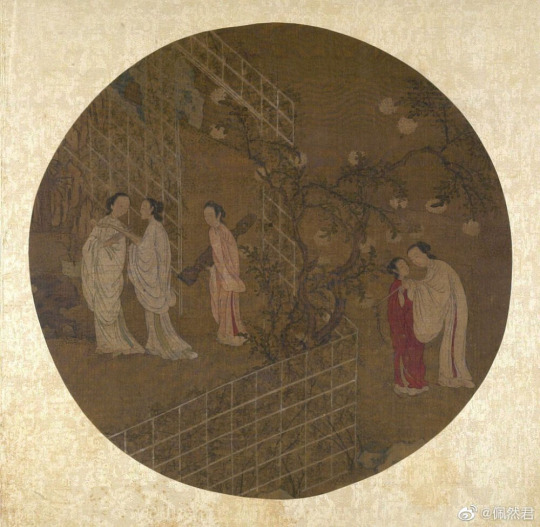
Intro
Finally got around to writing this series! Couple notes before we begin. I will only discuss civilian fashion and not court dress because 1) Qing court dress is well documented and there are plenty of other people/blogs/articles that explain it better than I ever could 2) court dress doesn’t really count as fashion because it serves ceremonial/religious/political purposes and is not supposed to change. The overwhelming majority of English language information about Qing Dynasty clothing is about court dress and Manchu women’s fashion, so I will be doing a disservice to the era if I continued that line of discussion. It should be noted that most literature on court dress and Manchu women’s fashion is not flawless either; court dress is often flattened to “dragon robes” by white historians despite it not being a legitimate fashion history term, and much information about “Qing Dynasty” Manchu fashion is really about that of the early 20th century, the Republican era. That is outside the scope of discussion for this series. Instead, I would like to shed some light on the life and times of Han women’s fashion during the Qing, something strictly kept out of the canon of Chinese fashion history until very recently.
Before we jump into it, we need some context. Prior to the establishment of the Qing Dynasty, China was ruled by the Ming Dynasty under ethnically Han (majority ethnicity in China nowadays) rulers since 1368. A collection of Jurchen tribes from what is now northeastern China and parts of Siberia, who later called themselves the Manchus, conquered China in 1644. In order to solidify their power, the new Manchu rulers forced Han Chinese men to adopt Manchu style clothing and hairstyles, but Han women were allowed to continue wearing Han style clothing, which is why the second half of the 17th century appears to be the continuation of the late Ming Dynasty aesthetic.
However, the early Qing was undeniably distinct from the Ming Dynasty, and I will not tolerate anybody calling clothes from this era “Ming style”. It could potentially be considered hanfu, as it was worn by Han women exclusively----something up for the community to decide----but it definitely did not belong to Ming Dynasty proper. Although in the 1640s and 50s some resistance forces in the south (dubbed “Southern Ming”) were still around, it’s not really worthwhile to make the distinction for womenswear, so let’s place it under Qing Dynasty for convenience. I have berated 18th century erasure quite frequently and passionately in the past (and it’s often extended to the 17th century as well), if you have seen any of those posts you would know that Qing Han women’s fashion prior to the 19th century is routinely mislabelled as Ming because it didn’t adhere to 20th century stereotypes about the “Manchuness” of Qing clothing and supposed Chinese backwardness in the colonial imagination of the time. Because of this reason, please do not be surprised if any of the images from the first couple posts of this series appear to be depicting what is commonly considered “Ming Dynasty hanfu”; they do not, they were from the Qing, plain and simple. It’s often simply because people don’t pay enough attention to the dating of artworks.
I will use emperors’ reign years as a guide for eras in this series because oftentimes that’s the most accurate dating that exists for artworks (many are unclear as to the exact year/decade they were made in), though I would recommend using exact dates instead of emperors wherever possible.
Fashion of the Ming-Qing transition
Han women’s fashion of the very early Qing had significant overlap and continuity with the late Ming. I’m not very knowledgeable on the minutiae of Ming Dynasty clothing so do add/correct anything. The standard ensemble for Han Chinese women was the 袄裙 aoqun (alternatively named 衫裙 shanqun) ensemble consisting of a robe and a skirt. In the 1620s and 30s, the cut of the robe was extremely generous, the hem hitting about knee length and the sleeves almost touching the ground. The sleeves of this era (and often throughout Chinese history) were longer than that of the length of the wearer’s arms, meaning that the wearer is required to grab the cuffs of the sleeves in order to facilitate the use of their arms. Many consider this inconvenient nowadays, but keep in mind that these robes with huge sleeves were made for wealthy people who hired servants and didn’t need to do physical labor. Working class people wore shorter, tighter sleeves that could also be held up by a garter.
The robe had a fitted tall standing collar, as opposed to the cross collar popular in previous centuries. The standing collar in the 1620s and 30s was soft, unstiffened and closed by two 子母扣 zimukou, metal clasp buttons, one at the bottom of the collar where it touched the bodice and one at the middle of the collar. Collars with only one button also existed, and these would be worn folded over. Gold or silver piping on the collar began to be popularized on the collar. Robes were closed at the side under the right armpit, commonly with tie strings. The placket forms a straight diagonal line from the collar to under the armpit. In the 17th century, robes were commonly plain and unicolor, with only brocade/embroidery in the same color. When decorative patterns were used, they were frequently in a repetitive arrangement of small clusters of motifs. Light pastel colors or white were very popular. Undergarments whose cuffs could be seen on the outside were commonly red, providing a contrasting flash of color to the otherwise light and plain ensembles.

Illustration from the late Ming novel 鸳鸯绦, showing the large sleeves popular at the time.

Late Ming women’s robe from the Confucius Estate collection.
The skirt was usually of 马面 mamian construction, basically two pleated pieces of fabric with two unpleated sections at the middle each, called 裙门 qunmen, that are sewn onto a waistband with one unpleated section overlapping, creating a wrap skirt. It has ribbons attached to each end of the waistband and was closed by wrapping the skirt around the waist and tying with the ribbons. Throughout much of the Ming Dynasty, mamian skirts were decorated using 裙襕 qunlan, a horizontal row of gold brocade or embroidery across the skirt, whose placement and widths varied depending on the trends of the decade. In the 1620s and 30s, skirts became increasingly simple, and plain white skirts were all the rage. Decorative features like qunlan were frequently relegated to formal dress.
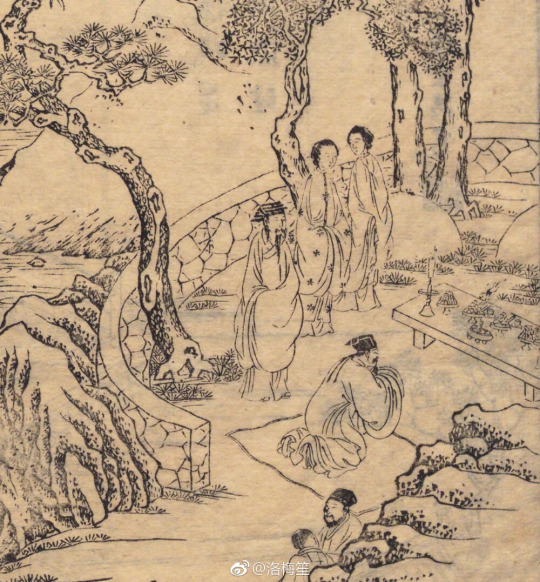
Illustration for the Chongzhen era novel 醋葫芦. The repetitive decorative patterns could be seen on the robe of the lady to the left.
Women’s hairstyle of this period is referred to as 三绺梳头 or “hair in three sections”, where the front of one’s hair would be divided into three sections, top, left and right, which would then be tied and coiled at the back, sometimes forming an elongated end at the bottom called a 燕尾 or “swallow tail”.

Late Ming/early Qing painting showing two fashionable women. The flash of red from the under robe is visible.
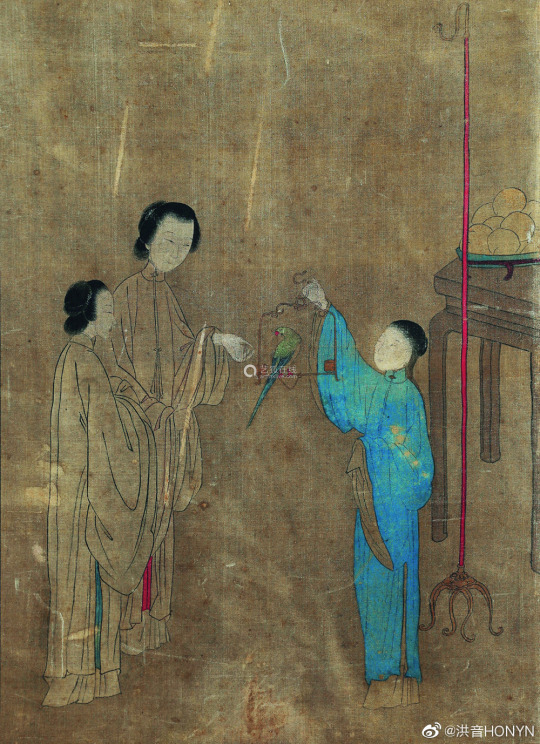
Beside the skirt and robe, women could layer a 披风 pifeng on top of the robe. These were equally generous in cut as the robe but had a 直领 zhiling, parallel collar, and were closed by tie strings or bigger decorative clasp buttons at the center front. It usually had a wide facing at the collar, which in the 1620s and 30s were often plain and in the same color as the garment.
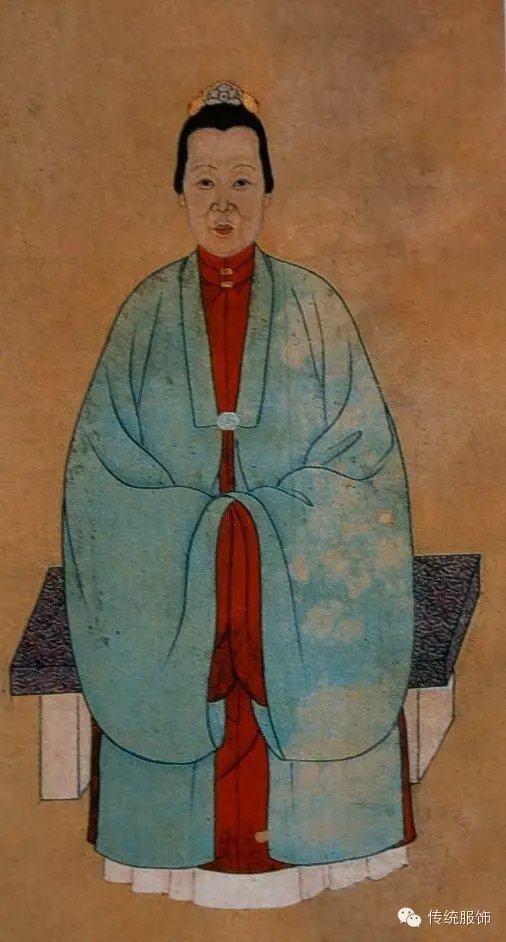
Mid 17th century portrait. This lady is wearing a plain red robe with gold buttons and piping, blue pifeng and plain white mamian skirt.
By the 1640s, the width of the sleeves had become smaller, and hairstyles became gradually fuller and more voluminous at the top, beginning the transition to the Kangxi era. The diagonal placket on robes began to be replaced by closures at the center front, often held together by tie strings.
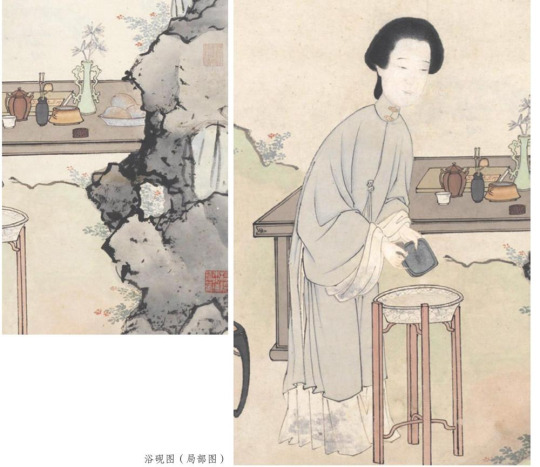
Section of 浴砚图 by 蓝瑛 Lan Ying and 徐泰 Xu Tai, 1659. We can see the center front closure with tie strings instead of the diagonal placket closing under the right armpit popular in previous eras.
Around this time, robes made of sheer fabric were being popularized as informal loungewear for warmer weather. Sheer robes were not proper enough to be worn outside, but we can catch a glimpse of these robes along with the undergarments beneath in romantic paintings with a domestic setting. The principle women’s undergarment for the upper body remained a 主腰 zhuyao, a tube top-like garment that provided bust support. It could have shoulder straps and was usually closed at the back with tie strings, though closures with cloth buttons became increasingly common throughout the Qing.

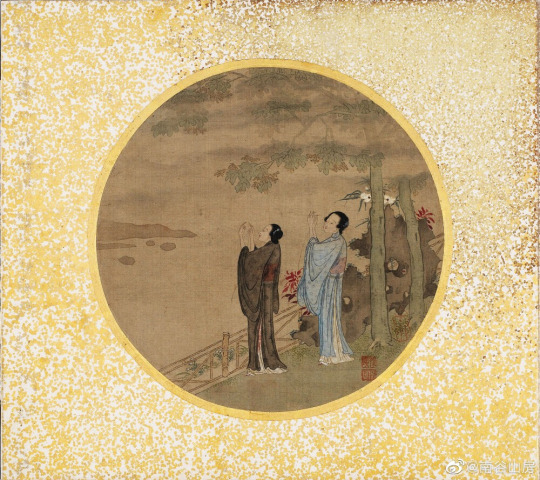
Shunzhi era painting series by Sun Huang (the cover image for this post is from the same series), showing a lady and her maids in lounging clothes, the zhuyao visible under the sheer robe.
--
I’m not as knowledgeable about the earlier parts of the Qing Dynasty as the later ones, so as always feel free to correct or add anything to this post :))
#qing dynasty#17th century#ming dynasty#shunzhi era#chongzhen era#abridged history of qing dynasty han women's fashion#chinese fashion#hanfu#fashion history
199 notes
·
View notes
Text




Was tasked with creating a character based on an object for class and I chose this lacquer tray with mother-of-pearl inlay from the Ming Dynasty
#character design#hanfu#ming dynasty#illustration#historical fashion#we were on our ming dynasty unit in chinese art history and i just was really hung up on mother of pearl inlay i had to do something with it#the fashion research is very cursory compared to like. my knowledge of western historical fashion#just fyi#junebugjo art
65 notes
·
View notes
Note
Thoughts on E-boy Pebbles?
if the mans desires to e-boy then who am i stop him. -goes on google images- the outfits fit him, but by god he would Not be able to pull off any swagger. n he'd be damned if he had to put any effort into putting stickers on his cheeks n shit (i never understood decorative skin stickers or whatevs those r called..... if I'M an old soul than he's not making it through)
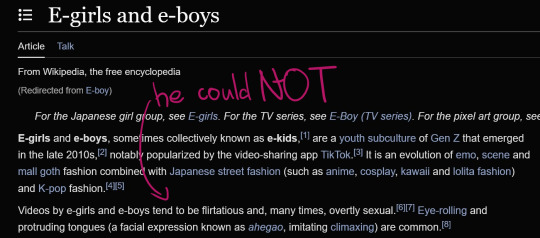
the whole catboy debacle proved to me that he wouldn't know How to act like that. actually i don't even wanna think about him acting like that. zoomer tiktok users scare me, man
#Spot says stuff#rw#my man my man. when it comes to fashion for Pebs. listen to me. google hanfu for men. trust me on this#thats what my take on him wears except yanno... yellow n simplistic for my hands sake. id LOVE to stick him in that kinda black fit#pebs to me is a tired college kid functioning only thanks to coffee. does Not give a shit about his appearance 87% of time but being a-#-history n culture/art nerd he would Absolutely own real hanfu. the moment he puts a hanfu on he is a changed man.#all beautiful and regal and proper. it boosts his self-confidence n ego So much. i cant even blame him i think wearing a hanfu would fix-#something in my brain chemistry
23 notes
·
View notes
Note
Hi! Was knitting ever used anytime in China up til the Ming Dynasty? I would assume it would've been exported there by late Qing, but I'm not sure about before then. Thanks!
Hi! Thanks for the patient… if you are still following my blog.
Modern knitting was definitely imported from Europe in the beginning and the first modern knit-wear factory was only established in Shanghai in 1896.
For the most part in China history, weaving was the main stream. Wool was also not used much in the central of the kingdom since they did not have much grass fields to keep wool-producing sheep.
There was something similar to a knit excavated from the Chu Kingdom (at least 2200 years ago), but it wasn’t a stand-alone piece of clothing but strips to be attached onto other piece of clothes to hide the seam. It is was also made with a different method compare to modern knitting and closer to nalbinding, and some considered it to be a type of embroidery.

However, if we look outside the central region, there are knit-like artifacts (mostly hats or head covers) from as early as Shang dynasty (at least 3000 years ago) to North and South Dynasties (1500 years ago) found in the north west areas. (I couldn’t find good pictures in the few searches that I did so no picture for this part).
If anyone have better resources feel free to add!
Reference
针织称谓起源的研究分析
中国早期手工编织的发展源流和技术分析
the Chu artifacts:
马山一号楚墓所出绦带的织法及其技术渊源
江陵马山战国针织绦带之再议
以出土实物为样本的针织提花织物研究
马山一号楚墓出土的丝织品(上)——云想衣裳系列
the north west artifacts:
西北地区出土古代针织物的组织结构研究
136 notes
·
View notes
Photo

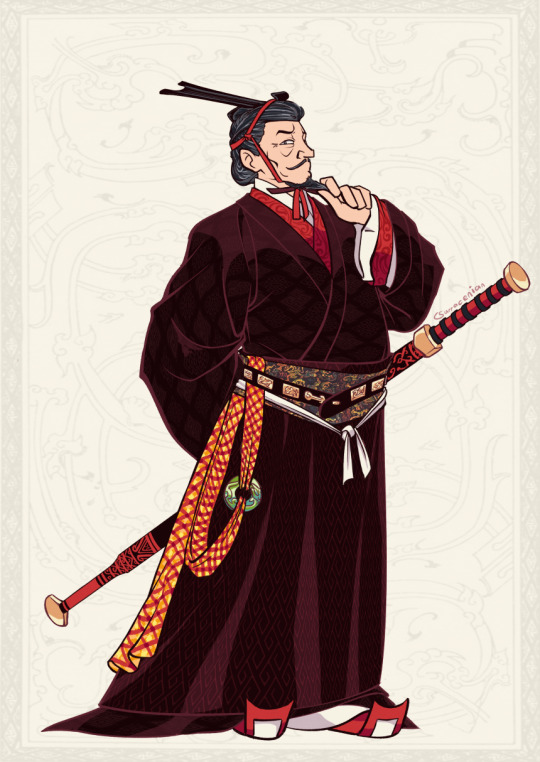
Qin & Han Dynasty Imperials
Contrary to popular belief, Chinese emperors and others in the imperial family would not have worn the more famous ceremonial Mianfu-robes during the Qin and much of Han Dynasty, but the more comparatively austere "Jūnxuán"(袀玄), which was a Qin invention, because they weren't into the Zhou-Etiquette informed Mianfu, as Qin Kingdom then later Empire dedicated its state philosophy to Hanfeizi's Legalism.
Which basically means Every Single Popular Depiction Of Qin Shihuang and Emperor Wu of Han you've likely seen are actually wrong hahaha
(You can read more of the history from my patreon here!)

(references used, more detailed in the patreon post)
#hanfu#chinese history#ancient china#han dynasty#qin dynasty#汉代#秦#historical fashion#chinese clothing
57 notes
·
View notes